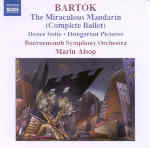Here’s a true story: A couple of decades ago I took a date to an opera performance at the MET. Sitting next to me was a very elegant, elderly woman scrutinizing the program of upcoming productions, one of which was the premiere of Jessye Norman’s double bill of Schoenberg’s Erwartung and Bartók’s Bluebeard’s Castle. The composers, however, were not mentioned in the list of titles, and so the lady turned to me pleasantly and said: “Excuse me, young man, but do you know who is the composer of Bluebeard’s Castle?” “Bartók,” I said. “Béla Bartók?” she asked. “Yes,” I nodded. “Didn’t he write The Miraculous Mandarin too?” “That’s the one,” I confirmed. “That’s my favorite piece!” she enthused, “I listen to it every morning at breakfast when I have my tea.” To say that I was startled would be an understatement. It turned out that her deceased husband had been an attorney and an associate of Bartók’s son, Peter, and so she was unusually familiar with the music in question. How she had missed out on Bluebeard’s Castle I didn’t ask, and anyway that’s not the point.
I couldn’t help but remember that charming old lady when listening to this unthreatening, dull performance of Bartók’s theoretically horrific, decadent ballet. It’s just the thing if you want to hear The Miraculous Mandarin as background music to your morning tea. The problems start right at the opening “traffic jam” music: no bite to the snare drum, tepid brass, restricted dynamics, and no sense of culmination at the climax. The solo clarinet in the seduction games sounds singularly unalluring, with loud gulps of breath breaking the phrases. Alsop’s contribution is conspicuous by its absence of positive qualities. Why doesn’t she get the trombones to play out in their mad duet just before the chase fugue, and why doesn’t she insist that the (here inaudible) accompanying cymbal rolls be executed on two plates as the score demands? Where is the rhythmic clarity to the ostinato that propels the chase fugue, which otherwise would justify Alsop’s comparatively moderate basic tempo? What about the atmospheric mystery and sense of terror that should characterize the entrance of the wordless chorus? In short, this effort sounds like a competent group of second-tier professionals putting in their time–nothing more–and I know that both Alsop and this orchestra are capable of much, much better.
If anything, the Dance Suite is even worse. Alsop’s approach is stiffly metronomic, with no swing, no earthiness (listen to those tepid trombone glissandos in the second movement), and therefore little rhythmic life. The sonics don’t help. Note that the ambient noises are as loud as the backwardly balanced woodwind solos at the beginning of the Allegro vivace. It’s not a question of being “Hungarian” in an idiomatic sense; there are plenty of fine performances of this music by international artists of all stripes. Alsop simply doesn’t get her musicians to characterize what’s in the score, and the engineering does absolutely nothing to enhance the impact and color of the playing. I suspect that the softer sections actually may be better than they sound, but frankly it’s impossible to tell. The Hungarian Pictures add nothing either positive or negative to this overall assessment.
Alsop has done some impressive work for Naxos, but as Katherine Hepburn said of her movie career, “You’ve got to know how to pick ’em.” Given intense competition at all price levels, not least from the outstandingly conducted and better sounding Dohányi/Vienna Miraculous Mandarin on budget-priced Eloquence, this was a bad pick, plain and simple.
































